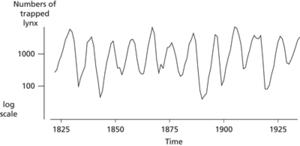A sequence of observations taken over a period of time, usually at equal intervals. Time series analysis is concerned with identifying the factors that influence the variation in a time series, perhaps with a view to predicting what will happen in the future. For many time series, two important components are seasonal variation, which is periodic change usually in yearly cycles, and trend, which is the long-term change in the seasonally adjusted figures.
A series of measurements over time, usually at regular intervals, of a random variable. A prime concern is the forecasting of future values using methods such as exponential smoothing, Holt–Winters forecasting, or Box–Jenkins methods. Models fitted include autoregressive models and moving average models. It is often necessary to deseasonalize the data and to remove any underlying trend (see moving average) before undertaking the analysis. See also periodogram.

Time series. The famous series illustrated shows the variation in the numbers of lynx trapped in the neighbourhood of the Mackenzie River, in Canada, for the years 1821 to 1934. The numbers of lynx vary according to the amount of food available. A major component of this food is the snowshoe hare, which shows a similar cycle: a rise in the lynx population leads to a fall in the hare population, which leads to a fall in the lynx population, which leads to a rise in the hare population, and so on.
A set of observations ordered in time and usually equally spaced; each observation may be related in some way to its predecessors. Time-series problems arise in economics, commerce, industry, meteorology, demography, or any fields in which the same measurements are regularly recorded.
Time-series analysis is based on models of the variability of observations in a time series, by postulating trends, cyclic effects, and short-term relationships, with a view to understanding the causes of variation and to improving forecasting (see also periodogram).
Autoregression is the use of regression analysis to relate observations to their predecessors. Moving-average methods use the means of neighbouring observations to reveal underlying trends. Autoregression and moving averages are combined in ARMA (or Box-Jenkins) forecasting techniques.
Cyclic influences may be of known period (months in a year or days in a week) and data may be seasonally adjusted on the basis of long-term means. Cyclic influences of unknown period may be studied by spectral analysis.
Analogous techniques may be used for data regularly ordered in space rather than time.
- Aurora
- aurora
- Aurora 7
- auroral oval
- auroral substorm
- aurous compounds
- Ausgleich (1867)
- AUSSAT
- Aussonderungsaxiom
- austenite
- austenitic stainless steel
- austerity measures
- Austerlitz, Battle of (2 December 1805)
- Austin, John (1790–1859)
- Austin, John Langshaw (1911–60)
- Australia
- Australia, fauna of
- Australian and New Zealand Journal of Statistics
- Australian Astronomical Observatory
- Australian faunal realm
- Australian Federation Movement (1890–1900)
- Australian Journal of Statistics
- Australian megafauna
- Australian Overland Telegraph Line
- Australian region